INDIA
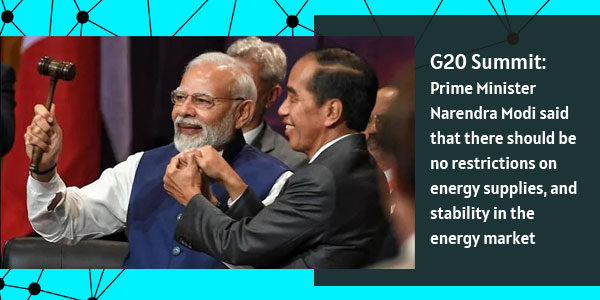
|
Speaking at the G20 Summit, Prime Minister Narendra Modi said that there should be no restrictions on energy supplies, and stability in the energy market should be ensured. Addressing the G20 working session on Food and Energy Security, the PM reaffirmed India’s committed to clean energy and the environment. The 17th G20 Summit was held in Bali, Indonesia on 15-16 November 2022. The G20 or the Group of Twenty is an intergovernmental forum comprising 19 countries and the European Union (EU). India has assumed the Presidency of G20 for a one-year term starting December 2022.
|
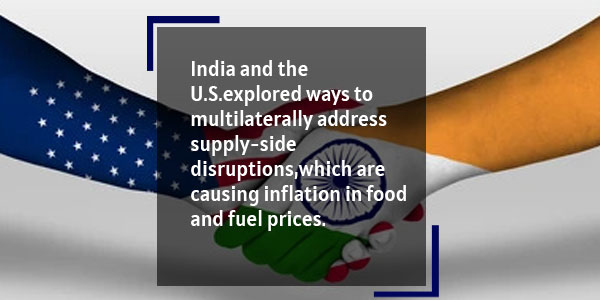
|
India and the U.S.explored ways to multilaterally address supply-side disruptions, which are causing inflation in food and fuel prices. The two major economies also discussed at the Summit measures to address challenges pertaining to the digital economy, including cryptocurrencies, and how to work together to fight financial crimes such as money laundering and tax evasion.
|
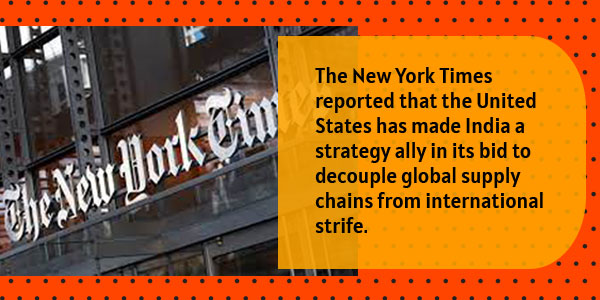
|
The New York Times reported that the United States has made India a strategy ally in its bid to decouple global supply chains from international strife. The economic superpower is looking to strengthen its ties with one of the world’s fastest-growing economies in the face of rising geopolitical tensions, said the publication.
|
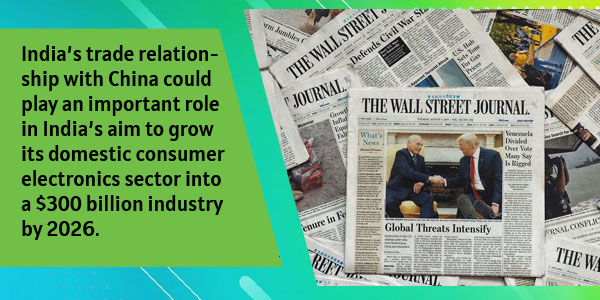
|
The Wall Street Journal has noted that India may have to open up to the China-linked supply chain to compete globally. The paper cited a recently issued report prepared by the National Council of Applied Economic Research (NCAER) for the CII, which said that India’s trade relationship with China could play an important role in India’s aim to grow its domestic consumer electronics sector into a $300 billion industry by 2026.
|

|
Writing for the Times of India, Nikhil Agrawal, President-CJ Darcl Logistics, posited that the National Logistics Policy (NLP) will be a game changer as an enabler for India in its aim to become $20 trillion economy by 2040. The Policywill help improve the turn-around time for companies, help in sustainable infrastructure development, create jobs, and help raise the country’s ranking in the World Logistics Performance Index.
|
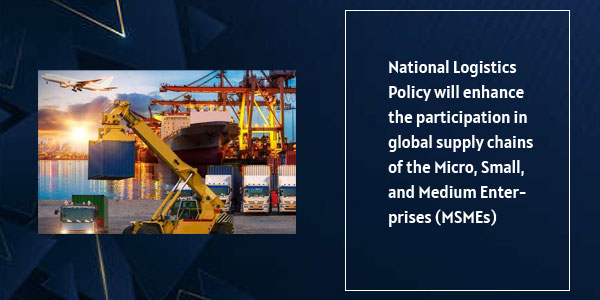
|
Another article on the NLP said that it will enhance the participation in global supply chains of the Micro, Small, and Medium Enterprises (MSMEs) which account for India’s 40 percent exports.
|
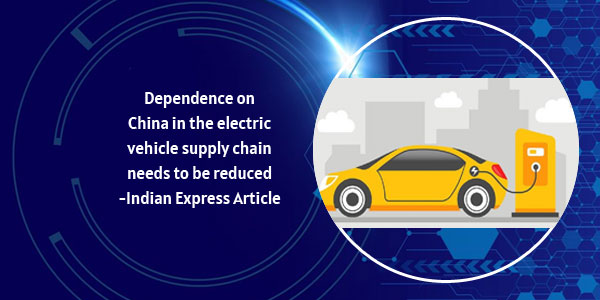
|
Dependence on China in the electric vehicle supply chain needs to be reduced, said an Indian Express article. The article pointed to a International Energy Association report which revealed that most part of the EV supply chain is highly concentrated in China including the processing of lithium, cobalt, graphite and nickel.
|
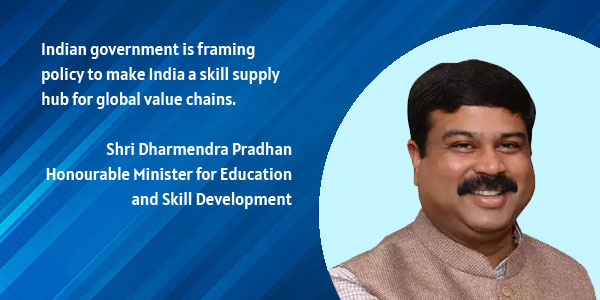
|
At a virtual Global Skills Summit organized in mid-November, the Minister for Education and Skill Development and Entrepreneurship Shri Dharmendra Pradhan told the attendees that the Indian government is framing policy to make India a skill supply hub for global value chains. He added that the global skill-set requirements will be mapped to identify the manpower needs of various economies during the process.
|
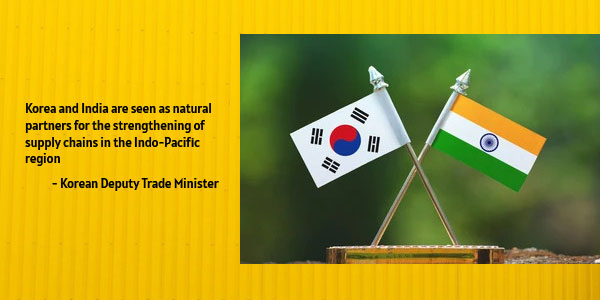
|
Korea and India are seen as natural partners for the strengthening of supply chains in the Indo-Pacific region, said the Korean Deputy Trade Minister speaking at the India Korea Business Partnership Forum. The Forum was organized by the Confederation of Indian Industry (CII) in partnership with Korea International Trade Association (KITA).
|

|
TVS Supply Chain Solutions has secured a new five-year contract from UK-based Dennis Eagle for aftermarket services.Dennis Eagle, part of the Terberg Environmental Group, is a leader in the design and manufacture of refuse collection vehicles.
|

|
India submitted its long-term strategy to achieve low greenhouse gas emissions at the COP27 UN Climate Change Conference that was held in Sharm el-Sheikh, Egypt from November 6-18, 2022. To achieve the net zero emissions target by 2070, India is promoting energy generation by renewables through capacity expansion and push for supply chain indigenization, among other measures.
|

|
The 5G technology, launched in India in October, will improve the efficiency, accuracy, and transparency of supply chain operations, according to an ET article. The technology will help speed up applications and processes such as package tracking and cloud-based inventory management, and reduce inventory errors through IoT sensors.
|
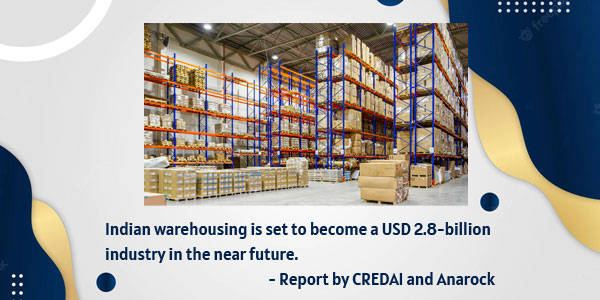
|
As per the recently unveiled India Warehousing Report by CREDAI and Anarock, warehousing is set to become a USD 2.8-billion industry in the near future. The reported added that the country’s Grade-A warehousing sector will show growth of 15 percent by 2025.
|
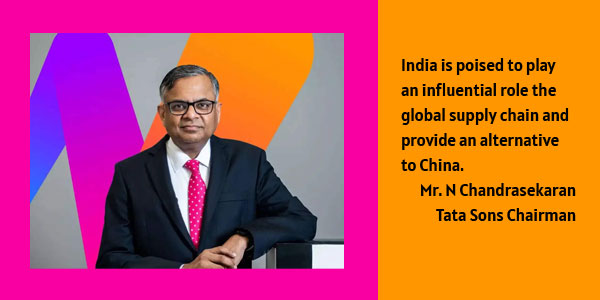
|
Tata Sons Chairman N Chandrasekaran has said that India is poised to play an influential role the global supply chain and provide an alternative to China. Speaking at the convocation ceremony of Anant National University in Ahmedabad, he said that they are entering the industry when recent developments have set in motion huge economic opportunities that will require the application of leadership skills from young professionals.
|
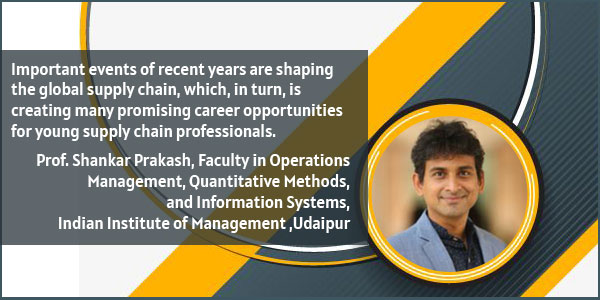
|
Prof. Shankar Prakash, Faculty in Operations Management, Quantitative Methods, and Information Systems, Indian Institute of Management Udaipur, highlighted the growing importance of a career in the supply chain industry. He noted that important events of recent years are shaping the global supply chain, which, in turn, is creating many promising career opportunities for young supply chain professionals.
|
INTERNATIONAL
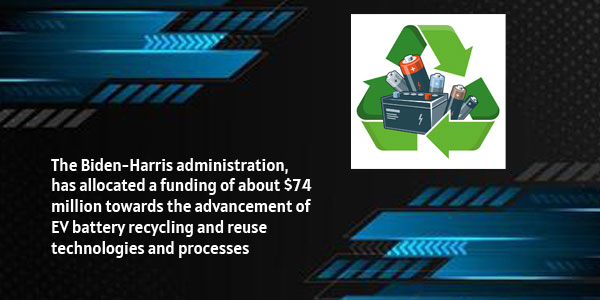
|
The Biden-Harris administration, through the U.S. Department of Energy (DOE), has allocated a funding of about $74 million from the government's Bipartisan Infrastructure Law toward the advancement of EV battery recycling and reuse technologies and processes. The DOE statement announcing this decision added that the funding will help accelerate battery production in the U.S, reduce risks emanating from battery supply chain disruptions and generate employment.
|

|
A Harvard Business Review article shared five lessons gleaned from recent strategies that the world's leading automakers adopted to navigate supply chain disruptions. Lessons include a recent strategy used by automakers to deliver a “good enough” product that saves on some non-essential features to prevent shipping delays since customers are more forgiving considering the events of the past few years. Others include developing better systems to monitor critical links in the supply chain and flag potential issues, and striking a balance between centralized and distributed decision-making.
|

|
The Wall Street Journal quoted industry executives and analysts to signal a "season of plenty" for holiday shoppers in the U.S. The report said that the stockouts seen during the last two holiday seasons could be absent this year due to factors like increased capacity, reduced demand owing to spending shifts from goods to services, and new and improved supply chain management strategies adopted by companies to prioritize delivery and inventory availability.
|

|
The U.S. healthcare industry’s supply chain experts shared their experiences with tech-enabled visibility and automation solutions for their supply chain challenges in a HealthTech magazine article. Featured leaders included senior supply chain officers of Cleveland Clinic and Missouri's BJC HealthCare. Solutions included simplification of supply chain, adoption of a Kanban system to improve management of low-value items, RFID technology and the creation of specialized zone rooms for clinicians to access all needed supplies.
|

|
Bloomberg Law's 2023 series previewed the top supply chain disruptors that its legal analysts will be watching in 2023. Some of these trends include extreme weather events, the threat of a global recession, and geopolitics.
|

|
A World Economic Forum article listed eight realities that are shaping the future of energy supply chains. They include the energy trilemma – the challenge faced by organizations and policymakers in ensuring a secure and reliable energy supply, at the right cost, with minimal environmental footprint.
|

|
UPS has announced the acquisition of logistics provider Bomi Group. Through the acquisition, the company aims to accelerate the expansion of cold chain capabilities across Europe and Latin America.
|
|
Interview of the Month
|
Avoid the pitfall of finding a solution in search of a problem
|

|
Sri Ram NKnowledge ExpertMcKinsey & Company
|

|
Amit V GuptaPartnerMcKinsey & Company
|

|
Dr. K GaneshAssociate PartnerSenior Knowledge ExpertGlobal Lead of (MSC) Centre
|
shared actionable insights with the CII-IL newsletter on important aspects of manufacturing and supply chain such as the go-to-market strategy for manufacturers, making the best use of digitalization, and the advantages of using the Design-to-value (DtV) approach.
|
|
Getting products to market is becoming trickier for manufacturers. Barriers to entry are lowering, which means players have to price competitively while also being innovative and creating market or segment differentiation. How should companies look at their products in today's context?
|
Delivering better and faster products to market has become more critical for manufacturers to stay relevant and successful. In the last few years, many leading organizations have started to focus on managing the costs of components used in manufacturing and efficiently sourcing raw materials, which account for 50% to 80% of the total cost of products.
It is key for manufacturers to integrate product design and analytics to create a step change in margin growth. Companies should focus on solving for specific, business-generated use cases, rather than becoming seduced by the newest, shiniest technologies. For example, companies often choose a new IT solution or add-on to an existing ERP system that promises to unlock siloed data across the enterprise. But by itself, "unlocking data" may not achieve much without understanding how the data will be used. In other words, without understanding the specific business use case, IT enablement alone is an incomplete solution, as it requires a well-thoughtout use-case orientation.
The emphasis on use case might sound obvious-but too often, companies encounter the common pitfall of starting with an answer in search of a problem, instead of a problem in search of an answer.
|
|
|
In a digital world, manufacturers are now privy to excessive data within organizations and from markets. How should companies leverage data to maximize margins and create a sustainable product portfolio?
|
Structured analytics enable deeper insights that can be scaled up across the business and ensure execution is sustained and accelerated, considering the customers, products, and supply base.
A combination of digital- and analytics-based practices enables dramatic increases in product-cost and portfolio-optimization efficiency. This method exploits product and procurement data (from a wide range of internal and external data sources) and applies a digital version of traditional material-cost- management practices. Design-to-value (DtV) exercises help companies innovate products and compete more effectively. Analytics to DtV combines insights from four lenses to drive improvements in price, cost, and customer penetration, with greater sustainability and rigor.
-
Customer insights: Product optimization starts with a solid understanding of customer needs, meaning companies must collect the right data to make quantified trade-offs between adding value and reducing cost. With a clear picture of customers' needs and wishes, the design process moves to concept creation. From a business point of view, the relative value of customers' wishes must be quantified and weighed against the respective cost in order to maximize product profitability.
-
Design insights: As high technical specifications so often drive product costs, an optimization effort-for example, through benchmarking against competitors' offerings-can significantly impact costs. Companies should emphasize design thinking that delights customers and lowers cost and product benchmarking for competitive insights who could be a market leader, a cost leader, or a technology leader.
-
Modularity and platform insights: Companies can optimize their product portfolios to increase margins while using modules, platforms, and standardization to reduce internal complexity. Find the optimum balance between diversity and standardization and address complexity's two distinct halves. External complexity, or the number of product lines and configurations customers can order, can be countered by optimizing the product portfolio, reducing its cost of complexity, and increasing margins. Internal complexity, on the other hand, depends on the sheer number of different components a company has to manage. Companies can often reduce this by introducing platforms and modules.
-
Supply insights: Identifying and securing the best cost point for product and service components-from a set of reliable and resilient suppliers-requires continual monitoring of price changes for both the components themselves and their raw materials. A company's suppliers should be equally focused on optimizing component costs. Creating cost transparency of product costs enables companies to optimize costs of the product considering raw material, value, and value-stream mapping.
|
|
|
How should companies view and execute DtV and analytics capabilities to multiply impact? How can they build core DtV capabilities at scale? How should an organization develop these capabilities?
|
Conventionally, companies build DtV capabilities by sending their existing pool of engineers to short-term courses to learn about the method and try out the tools. That approach has limitations. DtV requires intense cross-functional collaboration to identify optimal solutions and manage complex trade-offs. Hence, it requires creating a dedicated team of DtV practitioners providing intensive, immediate support to projects at critical inflection points. And over the long term, the team can also train colleagues throughout the company in DtV capabilities, strengthening DtV for the entire organization.
The organization's capability building can be kick-started by having a separate but not isolated team that is adequately supported by the right resources, capabilities, and infrastructure. Hire or grow talents within dedicated departments with clearly defined roles and responsibilities that are integrated and aligned into the organizational and project-specific processes. Build the team's capabilities by creating cross-functional representation within products, technologies, categories, and manufacturing processes.
Develop a pool of internal and external subject matter experts who bring value to the assessment and provide expert support, coaching, and on-the-job training. Set up infrastructure with physical space for members to conduct competitive benchmarking and ideation and provide digital analytic tools to uncover insights, such as product libraries, max-diff methods, and cost-of-complexity calculators.
|
|
|
With global supply chains in disarray, consumer goods companies are scrambling to ensure their products get to market in a consistent, sustainable, and timely fashion. Despite their best efforts, many are still struggling with extended delays in filling orders, empty shelves, and lower customer satisfaction. An often-overlooked lever in this broader tool set is "skinny design", which involves reassessing the overall box size of products by reducing the total cubic volume of the package. What is the best-in-class process to embrace skinny design?
|
One of the advantages of skinny design is that consumer goods companies can implement this strategy with a relatively low up-front investment. To capture the value at stake, organizations must be prepared to embed new ways of measuring progress and value, develop new capabilities, and adapt the way they work. To ensure a successful rollout, companies can follow a three-step process.
1. Setting the aspiration
-
First, companies need to understand the size of the opportunity in order to create the business case. This case is typically made up of a mix of growth associated with reducing stockouts and cost through freight savings.
2. Establish the technological foundation
-
Once the business case is clear, the second step is using advanced tools that can build the fact base to determine the specific packaging levers to target. For example, companies can investigate publicly available dimensions of competitors' packaging to identify significant deviations from industry benchmarks. One cereal manufacturer used a digital teardown database to compare the volume of its own packaging to that of competitors (normalized for cereal type and weight). The tool uncovered an average cube optimization opportunity of approximately 33 percent across five of the company's cereal boxes. If fully implemented, this approach could translate reduction in its logistics costs and CO2 footprint.
3. Implement new ways of working
-
The third step is making the changes to packaging or product design. As previously mentioned, one way to accomplish cube optimization is to focus design changes and upgrades solely on packaging components-for example, rearranging how LED bulbs are packed inside the corrugated retail box to eliminate empty space between units, or reducing overhead and lateral space in the case of cereal or TVs. Companies may also accomplish space optimization by redesigning the product itself. This last angle may yield more innovative and effective results, although it tends to be more resource intensive (as measured by funding and time, among other elements) than packaging redesign, while requiring closer coordination between organizational elements.
The supply chain challenges confronting consumer goods companies show little sign of abating, meaning a return to normal could be years away. The acute need to explore all solutions makes design a potent tool for achieving real benefits for a relatively small investment. Organizations that build the internal muscles now to embrace skinny design will be better positioned to confront supply chain constraints in the future.
|
|
|
Will connect again next month, with a comprehensive dossier of news, trends and events from the industry.
|
|
|
|
|
|
|

























